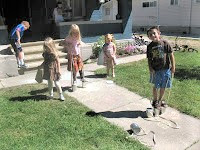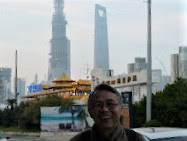Not long ago, my sister told me that my maternal grandfather, prior to coming to North Borneo (now renamed Sabah) in fact first went to work in a mine in Malaya. According to what my mother told her, the mine he worked at was a very "deep" mine. She was however unable to pin-point the exact location of the mine.
When my wife heard this, she has no hesitation to tell me that the mine my sister talked about is the tin mine in Sungai Lembing.
Sungai Lembing is an old mining town situated at about 40 Km northwest of Kuantan in the state of Pahang in Peninsular Malaysia. A river traverses across this town which eventually discharges to the sea not far from Kuantan. According to the local Chinese, the name Sungai Lembing (林明) was named after an Indonesian Chinese who after knowing the abundance of tin in this location decided to come and to invest in its extraction. Until 1970, it was the biggest tin producer in the world and also held the record of deepest mine shaft (Read here).
 |
| Sungai Lembing: 3054’ 46.44”N, 1030 1’ 57.94”E |
A British company Pahang Consolidated Company Limited (PCCL) was given the right to extract tin in 1891. This tin mine was in operation from 1906 until its closure in 1986 when world tin prices collapsed. Tin was mined via deep tunnels stretching a total length of 322 Km with depth of between 610 m (2,000 ft) and 700 m (2,300 ft).
In the early 20th century, PCCL went to China to recruit Chinese from the southern part of China to come and work in the mine. I believe my grandfather was one of those Chinese who were recruited. These Chinese probably landed first near Kuantan and then moved by boat along the river to reach this mining town. At its peak, PCCL had a work force of close to 1,500. The company also built quarters and cinema for their workers.
My grandfather however did not worked in the mine very long. His reason for leaving Sungai Lembing for North Borneo was sadly unknown.
Today, Sungai Lembing is in decline since the mine's closure in 1986. People who stayed on are mostly the older folks who are the descendants of the early Chinese who came from China. Most of the new generations have chosen to move to bigger towns.
These days, many tourists come to Sungai Lembing to see some of the remaining 100+ years old buildings, long suspension bridge, old trees and to taste some of the well known dishes and delicacies.
Recently, Astro featured a documentary about this town. I managed to capture some of the old photo's shown.
















I hope to visit Sungai Lembing in the not too distant future, to explore and to taste some of the much talked about food and delicacies. Who knows, I may be lucky to find out some information about my grandfather!
Sungai Lembing yong tau fu: made from stream water that originates from untouched jungle


100 + years old tree (百年老樹): Then and now

Suspension Bridge

Suspension Bridge






































